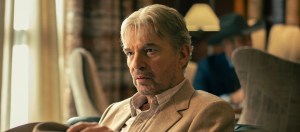No matter what the genre, a film’s music is meant to help set the tone of a film before an audience ever gets to know a single character or before a plot begins to unravel, with the opening sounds either able to make or break every second of footage that follows it.
When Star Wars begins, the grand, sweeping orchestra lets you know you’re about to go on a timeless adventure, the likes of which have never been seen before. With Ghostbusters, the viewer is promised a light-hearted romp with all sorts of goofy shenanigans, mirrored in Ray Parker, Jr.’s catchy theme. Back to the Future’s opening rhythms remind you that love will be at the heart of the story, which drives Marty McFly to do the unthinkable to make sure his parents stay together.
Videos by PopCulture.com
Horror movies, on the other hand, are a completely different beast. In some instances, the music is meant to unsettle or frighten you before you even begin to see terrifying visuals, while in other instances, the music is meant to calm and comfort you in hopes of making the unsettling story you’re about to see feel all the more horrifying.
Some of the most iconic and recognizable movie music of all time comes to us from horror movies, giving composers an opportunity to showcase their skills in a genre whose merits are often overlooked by many.
Scroll down to hear some of the best and most iconic horror movie theme songs!
Psycho (1960)

It should come as no surprise that one of the defining visionaries in the world of horror also helped spawn one of the most exciting horror movie themes.
In Alfred Hitchcock’s Psycho, based on Robert Bloch’s 1959 novel, Norman Bates (Anthony Perkins) was the seemingly innocuous proprietor of a small, roadside motel where Marion Crane (Janet Leigh) stops by in hopes of hiding out from her old job, from which she stole $40,000.
Being pursued by her employer is one of the least of Crane’s worries, as a conversation with Bates leads to deadly consequences, with the film documenting the investigation into who killed the attractive woman and what Norman’s involvement in the crime was.
The film’s composer, Bernard Hermann, was paid a reduced fee for the movie compared to other projects he worked on, resulting in his reliance upon a string orchestra instead of a complete symphony. Hitchcock was so pleased with the music, he claimed that “33%” of the film’s effectiveness was due to Hermann’s score.
The Exorcist (1973)

The initial music written for The Exorcist, composed by Lalo Schifrin, was reportedly considered “too scary” by the Warner Bros. executives, having at first only been used in the film’s trailer. The film’s director, William Friedkin, was ultimately unhappy with the music Schifrin created for the film, opting to instead use a variety of pre-written classical musical pieces to heighten the film’s atmosphere.
Mike Oldfield’s “Tubular Bells” became such an iconic piece of music in the film that it went on to regularly be referred to as “The Exorcist Theme.”
Despite the legacy that the song’s use in the film created, Oldfield has gone on to say that he was unhappy with the song’s use in the film, only for it to earn the musician acclaim.
The song manages to not only conjure images of the classical use of bells in religious music, but also creates an eerie and unsettling stage for which the events of The Exorcist to unfold.
Jaws (1975)

Composer John Williams has created some of the most memorable theme songs in the history of film, ranging from Star Wars to Raiders of the Lost Ark to Jurassic Park to Harry Potter. Unsurprisingly, Williams’ foray into the world of horror also resulted in an iconic theme, but what makes the theme so special is how much the composer accomplished with such minimal notes.
Jaws tells the tale of a small island town that is being targeted by a rogue great white shark, picking off the occasional swimmer that wades too far into the depths of the ocean, posing a massive threat to the upcoming wave of tourists hoping to celebrate July 4th. The town’s police chief, a shark expert, and a shark fisherman embark on a journey to put an end to the aquatic threat once and for all, unsure of where it came from or why it’s made the town of Amity a temporary home.
Williams’ main theme, which alternates between two notes, mimics the primal nature of the shark, with the tempo increasing throughout the song to conjure images of a looming threat, getting ever closer to its prey, unbeknownst to the target.
Suspiria (1977)

Having previously worked together for the film Deep Red, director Dario Argento tapped Italian prog-rock band Goblin to craft the score for this tale of witches.
When an American arrives at a ballet school in Germany to study under the tutelage of one of the world’s most accomplished teachers, a series of bizarre occurrences begin to unfold, from students disappearing to maggots raining from the ceiling. The American begins to pry into the school’s history, hoping to find answers for these events, only to learn the school’s connection to the world of witches.
Written prior to having seen the film, Goblin’s score and, most notably, its main theme, channels both the disco and rock sound of the time, while injecting it with playful sounds and notes that conjure innocence.
The success of the theme became such that it was considered to be one of the 500 best songs from “Punk to Present” in a book released by Pitchfork, with the Russian synchronized swim team embracing the erratic sounds to use in their 2012 Olympic routine.
Halloween (1978)

Although many would cite Eyes Without a Face, The Texas Chain Saw Massacre, and Black Christmas as some of the first slashers, few would argue that John Carpenter’s Halloween would help define the subgenre and set a formula that horror movies would follow for years to come.
Carpenter used a synth-heavy score with repetitive melodies while telling the story of a psychotic killer returning to the town in which he grew up, stalking and killing teenagers without any discernible rhyme or reason.
While some horror films aimed to recreate the same sonic formula as Halloween, many horror films also used the theme as an example of what they didn’t want to do, with Friday the 13th using atmospheric soundscapes for its sequences instead of recognizable tunes.
Phantasm (1979)

Despite being one of the lesser-known films on the list, the power of Phantasm‘s score cannot be denied.
With slashers and serial killers on the rise in the late ’70s, Phantasm told the incredibly bizarre story of a strangely tall man who stole corpses from our dimension to send to another dimension, where the individuals would serve as slaves. Fearful that any of his friends or family members could become a zombie servant to this Tall Man, a 13-year-old sets out to uncover the nefarious activities of the local mortician.
A far cry from the more straightforward narratives found in films in the late ’70s, the film’s theme also invoked the surrealistic and idiosyncratic nature of the plot, combining the influences of both Goblin and Mike Oldfield for the memorable theme.
Saw (2004)

With synth music dominating most films of the ’80s and the ’90s being saturated with compilation tracks from whatever the hottest artists were at the time, the notion of a recognizable and repeated piece of music diminished drastically in those two decades.
Considering all of the previous films on this list have spurned multiple sequels (with Suspiria being the exception), the themes gained recognition for being repeated in each subsequent film. Throughout the ’90s and the ’00s, the only franchises to have such repeated successes were the likes of Scream, Final Destination, or Paranormal Activity, with most films trying to avoid connections to franchises that came before them. Saw, on the other hand, knew the power of a recognizable theme.
The music itself combined elements of industrial and electronic music, while also infusing it with a touch of playfulness, reminding viewers that the film often relied on the concept of a killer who merely wanted to “play a game” with its victims.
Honorable Mention: A Nightmare on Elm Street (1984)
While maybe not quite as distinctive as some of then other film on our list, A Nightmare on Elm Street still had one of the most fitting horror movie themes for its plot.
It used jarring rhythms to recreate the surrealism of a killer who attacks you in your nightmares.








